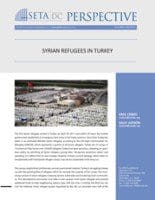
Syrian Refugees in Turkey
April 4, 2014Turkey has been generous with Syrian refugees, adopting an open-door policy, giving “temporary protection status” and spending $2.5 billion.
 The first Syrian refugees arrived in Turkey on April 29, 2011 and within 24 hours the Turkish government established an emergency tent camp in the Hatay province. Since then Turkey has taken in an estimated 800,000 Syrian refugees, according to the UN High Commissioner for Refugees (UNHCR), which represents a quarter of all Syrian refugees. Turkey has 22 camps in 10 provinces that house over 224,000 refugees. Turkey has been generous, adopting an open-door policy by admitting all Syrian refugees, giving them “temporary protection status” and spending $2.5 billion from its own budget. However, Turkey’s current strategy, which relies on exceptionally well-maintained refugee camps, may not be sustainable in the long run.
The first Syrian refugees arrived in Turkey on April 29, 2011 and within 24 hours the Turkish government established an emergency tent camp in the Hatay province. Since then Turkey has taken in an estimated 800,000 Syrian refugees, according to the UN High Commissioner for Refugees (UNHCR), which represents a quarter of all Syrian refugees. Turkey has 22 camps in 10 provinces that house over 224,000 refugees. Turkey has been generous, adopting an open-door policy by admitting all Syrian refugees, giving them “temporary protection status” and spending $2.5 billion from its own budget. However, Turkey’s current strategy, which relies on exceptionally well-maintained refugee camps, may not be sustainable in the long run.
The camps, despite their pristineness, are not a permanent solution. Turkey is struggling to keep up with the growing flow of refugees, which far exceeds the capacity of the camps. The increasing number of urban refugees is leaving Syrians vulnerable and burdening local communities. The international community must take in and support more Syrian refugees and provide additional funds to help neighboring nations cope with the crisis. Currently, the West has not met the relatively minor refugee quotas requested by the UN, nor provided even half of the requested funds to help Turkey care for the refugees. Without a show of solidarity from the international community to share the burden of the Syrian crisis, Turkey will continue to struggle under the growing costs of thousands of refugees who will be unable to return to Syria for many years.
“Five Star” Camps
Refugee camps in Turkey have been described as “five star,” exceeding many international standards for camp conditions. Fieldwork done in 2013 showed that 88% of refugees said they were “satisfied” or “very satisfied” with the camps. There are clean streets, power lines, health centers, grocery stores, playgrounds, community centers, laundry rooms and schools. Rather than relying on the UNHCR to establish and run the refugee camps, the Prime Ministry’s Disaster and Emergency Management Presidency (AFAD) is in charge of the refugee effort. The camps are staffed by Turkish employees and NGOs are given supporting roles. This allows the government to maintain control over the refugee camps and simplify the support process, as different NGOs often have overlapping services.
The Turkish government appoints camp staff members, who report to the camp administrator, who in turn reports to the governor of the region. This model minimizes some of the issues associated with refugee camps, such as diversion of supplies, crime, black markets and sexual assault. Food is delivered through an e-Food Card program and the costs are shared by the AFAD and the World Food Programme (WFP). Each family is given a debit card when they register as refugees and a monthly budget of 80 Turkish lira (nearly $40) to spend as they wish at the camp grocery stores. This allows refugees to have a certain level of independence and is beneficial for local grocers ... Continue Reading



























